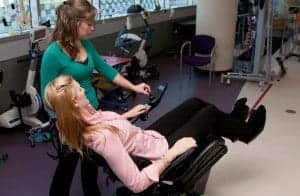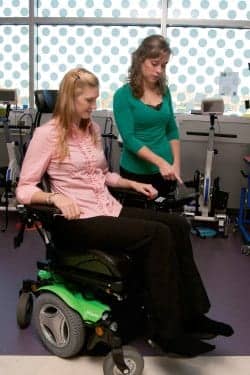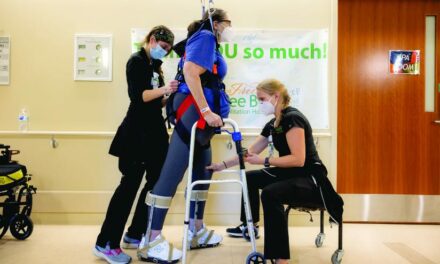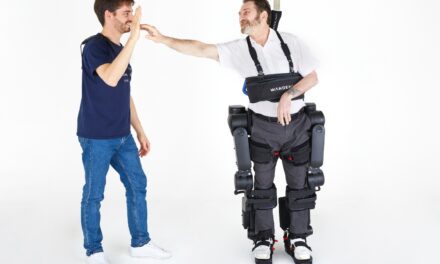
Power seat functions allow for position changes and pressure reliefs throughout the day. They can be accessed through separate switches or through the joystick.
As an avid runner, Kate, now 33 years old, first knew something was wrong in 1997 when she began to continuously trip over her right foot. Initial examination revealed drop foot, while progressive symptoms and further testing led to a diagnosis of multiple sclerosis (MS). This disease of the central nervous system results from the body’s own immune system attacking and damaging the axons of the brain and spinal cord. Symptoms of MS present in “relapses” or exacerbations with a gradual deterioration of function over time and typically lead to progressive mobility impairment.
As Kate experienced exacerbations, her mobility began to decline. Initially, she would depend on friends and family for support while walking, refusing the transition to a walker or cane because she “associated such devices with old people.” With continued loss of function, Kate accepted the transition to a manual wheelchair, as she believed that this was a more plausible device for someone her age. A decision to add power assist wheels to her manual chair was fueled by the wish to return to driving. Kate pursued an adapted vehicle, but knew she had lost the arm strength necessary to propel up the vehicle’s ramp independently. In addition, she had begun to rely on friends and family to push her around and wanted to regain some of her independence. The power assist wheels also would allow her to maintain her full-time job as a ninth grade world history teacher, which she sees as her most important life role.
Further relapses of her disease led to increases in abnormal tone, loss of strength through her arms and trunk, and increasing fatigue levels. It became more and more of a struggle for her to propel herself, even with the power assist wheels. Kate again began to rely on friends and family to push her from point A to point B. In addition, after returning home from work, she would find herself asking for assistance with tasks she once performed easily on her own due to increasing fatigue and exhaustion levels.
Kate began to toy with the idea of a powered mobility device to regain her independence. After 7 years in a manual wheelchair, she ordered a scooter for part-time use. The scooter allowed her to take her dog for longer, faster “walks” and go out in the community with friends. Kate continued to take her manual wheelchair with power assist wheels to work, as the scooter did not provide enough postural support for a full day’s use. The number of tasks she required assistance with at home continued to grow as her independence declined and fatigue limited her ability to move throughout the school and endure class periods.
Kate became aware of the impact that her increasing disability was having on her life. Continued progression of her disease was leading to further decline in upper extremity and trunk function and increasing spasticity. She was able to propel only very short distances prior to becoming too fatigued, and her speed of propulsion was significantly impaired. She could not independently change positions in the chair, resulting in inability to adapt her comfort level, rest, or perform an independent pressure relief. Kate also began to fear for her safety while in her manual chair. She had experienced multiple falls, and she realized the fear of falling began to limit her willingness to go out with her friends.
In February 2010, Kate began to entertain the idea of transitioning to a power wheelchair as her primary means of mobility and presented to the seating clinic of the International Center for Spinal Cord Injury at Kennedy Krieger Institute for evaluation and assessment, and to learn about available products and their functions. She participated in the evaluation, but it was apparent she was hesitant about the transition and she verbalized that she was having a difficult time coming to terms with the need for a power chair. Kate trialed driving different power chair brands and drive types. She also trialed the different power seat functions, such as tilt, recline, seat elevator, elevating legrests, and standing. At the conclusion of the appointment, it was decided Kate would take some time to think over the decision.
Soon after, Kate decided not to pursue the power chair. Kate explained, “To be 100% honest, there was no major reason that I did not go through with the chair other than image.” She further explained she was afraid of how others would see her after she transitioned to a power wheelchair. In Kate’s mind, the bigger the device she was in, the smaller she would become; the less of her people would see. And Kate is not alone in this feeling, as research shows that the social environment is a significant factor in the decision about whether to pursue power mobility. Persons with disability are fearful of the negative attitude of others toward their “obvious” disability while seated in a power wheelchair.1 The power mobility device can be viewed as a symbol of lost function and greater disability, and there is a fear of the stigma attached to the device.2

Instruction in the functions of the chair is an important part of the initial evaluation and fitting and delivery processes.
Seven months later, in September 2010, further decline in function and the loss of participation in her most valued activity forced Kate to revisit pursuing a power chair. Her disability had progressed to where she was no longer able to transition between the manual wheelchair and the scooter alone. Prior to her caregiver leaving each morning, Kate would transfer into either her manual wheelchair or her scooter. If she got into the manual wheelchair, she would be unable to leave her apartment because of her limited propulsion ability. She could not take her dog for a walk, enjoy the local galleries or shops, or meet friends out that day. She was home bound. In addition, she could not modify her position, resulting in pain and discomfort and fear of skin breakdown.
Still, even more devastating than greater loss of mobility was the fact that Kate lost her ability to teach. Kate became too fatigued to keep up with the demands of teaching and was forced to leave work on disability. It was at that moment Kate decided the time had come to make the transition.
Kate is not alone in her experience. Many persons with MS consider making the transition to a power mobility device for a prolonged period of time, and most can describe a specific moment when they had to finally face the reality of needing to take that next step. This moment usually involves losing the ability to participate in a valued activity.1 For Kate, the loss of the ability to teach was the final straw. She loved to teach; it was the one thing she felt gave her purpose. If a power chair could get her back to teaching, then it would be worth it.
Kate again presented to our seating clinic for a power chair evaluation. Not only would the power chair reduce fatigue and promote mobility, it also would support upper extremity preservation, increase her safety, and reduce risk of skin breakdown. It was decided to pursue a mid-wheel drive chair with custom seating system to promote ease of navigation through her environments and proper postural alignment and support. Multiple power seat functions, including tilt, recline, and elevating legrests, would be added to promote independent position changes and pressure reliefs throughout the day. A power seat elevator also was deemed necessary to increase ease of transfers, facilitate eye-to-eye communication with her students, and limit repetitive overhead reaching at school and home.
A letter of medical necessity documenting Kate’s current status and how the power wheelchair and each of its features would promote greater independence, safety, and function was drafted and submitted to her primary insurance company to promote funding.
With the final specifications laid out, a letter of medical necessity (LMN) was drafted to promote funding. To gain approval for a power wheelchair, the LMN must clearly lay out the patient’s non-ambulatory status and reasons why the combined use of a manual wheelchair and scooter cannot meet the patient’s mobility needs. After this is explained, the LMN must then express how the transition to a power chair will positively impact the patient’s mobility in the home and ability to perform ADLs and IADLs independently. Because Kate had private insurance, it would be important to clearly document how the power wheelchair would assist her community mobility and promote her continued employment. The progressive nature of MS can make it easier to ensure funding, because decline in function and loss of independence can be used to document the need to transition to a more complex device. Further strengthening the case for funding is that the adaptability of a power wheelchair and its electronics will promote her independence for longer, which limits the need for private care. The completed LMN and a script from the physician were then submitted to Kate’s insurance company for approval.
Kate received her new power chair in November 2011 and is highly satisfied with her decision and newfound independence. In fact, she now recognizes that her “stubbornness ended up hindering [her] independence more than helping it.” Her fatigue levels are down, allowing her to decrease reliance on caregivers and maintain greater autonomy. Kate is also again able to move freely in and out of her apartment, allowing her to enjoy the many perks of her neighborhood and to take out her dog as needed. Most importantly, though, her main goal was achieved and she has returned to teaching full time.
The transition to the power chair will promote Kate’s independence through the progression of her MS. If she loses the ability to drive with a joystick, there are many other drive mechanisms, such as a head array, a chin control, or scanning with a single switch, that can be added. In addition, most power chair electronics now support the integration of an electronic aid to daily living (EADL) or environmental control unit (ECU). Kate would be able to control one or more electronic appliances (such as a phone, TV, or computer) through her drive controls by switching to the EADL mode of her chair.
The decision to transition to a power chair can be daunting for someone with a progressive disease. There are many factors that are considered in making the decision, which includes coming to terms with further decline in function and prioritizing independence over the perception of self and others about the device. It is important to provide support to clients during this process by educating them about options and shedding a positive light on the freedoms the power chair can provide and ways the device can promote autonomy for a greater length of time. Most importantly, however, is letting the client come to terms with the need for the device in their own time. For Kate, she knew we were here for her whenever she was ready, and the day that she lost the ability to teach, the decision for her finally became an easy one.
Erin Michael, PT, DPT, ATP, is a physical therapist and a seating and mobility specialist at the Kennedy Krieger Institute’s International Center for Spinal Cord Injury in Baltimore. She specializes in treating paralyzing neurological conditions, including multiple sclerosis, transverse myelitis, cerebral palsy, and traumatic brain and spinal cord injury. For more information contact
REFERENCES
- Boss TM, Finlayson M. Responses to the acquisition and use of power mobility by individuals who have multiple sclerosis and their families. Am J Occup Ther. 2006;60:348-357.
- Buning ME, Angelo JA, Schmeler MR. Occupational performance and the transition to powered mobility: a pilot study. Am J Occup Ther. 2001;55:339-344.





